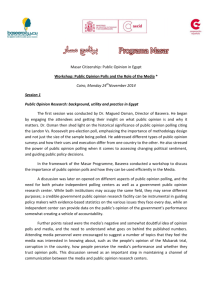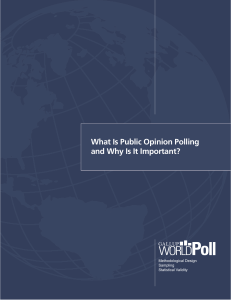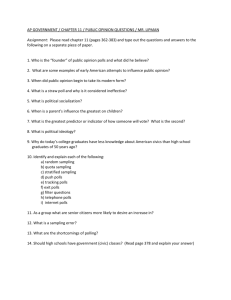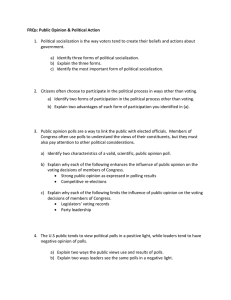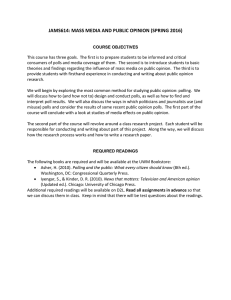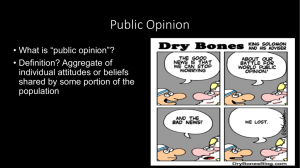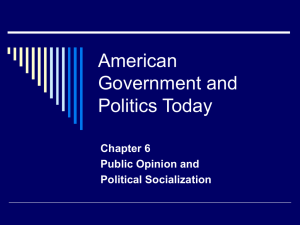POLI 300 N. R. Miller I. survey research
advertisement
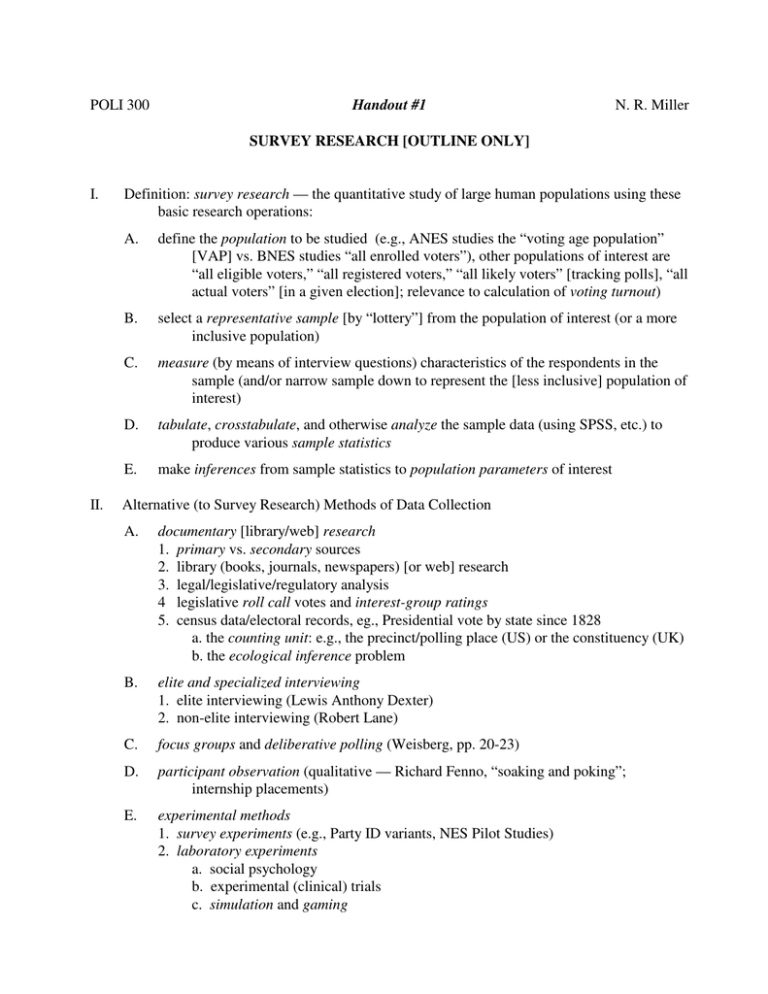
POLI 300 Handout #1 N. R. Miller SURVEY RESEARCH [OUTLINE ONLY] I. II. Definition: survey research — the quantitative study of large human populations using these basic research operations: A. define the population to be studied (e.g., ANES studies the “voting age population” [VAP] vs. BNES studies “all enrolled voters”), other populations of interest are “all eligible voters,” “all registered voters,” “all likely voters” [tracking polls], “all actual voters” [in a given election]; relevance to calculation of voting turnout) B. select a representative sample [by “lottery”] from the population of interest (or a more inclusive population) C. measure (by means of interview questions) characteristics of the respondents in the sample (and/or narrow sample down to represent the [less inclusive] population of interest) D. tabulate, crosstabulate, and otherwise analyze the sample data (using SPSS, etc.) to produce various sample statistics E. make inferences from sample statistics to population parameters of interest Alternative (to Survey Research) Methods of Data Collection A. documentary [library/web] research 1. primary vs. secondary sources 2. library (books, journals, newspapers) [or web] research 3. legal/legislative/regulatory analysis 4 legislative roll call votes and interest-group ratings 5. census data/electoral records, eg., Presidential vote by state since 1828 a. the counting unit: e.g., the precinct/polling place (US) or the constituency (UK) b. the ecological inference problem B. elite and specialized interviewing 1. elite interviewing (Lewis Anthony Dexter) 2. non-elite interviewing (Robert Lane) C. focus groups and deliberative polling (Weisberg, pp. 20-23) D. participant observation (qualitative — Richard Fenno, “soaking and poking”; internship placements) E. experimental methods 1. survey experiments (e.g., Party ID variants, NES Pilot Studies) 2. laboratory experiments a. social psychology b. experimental (clinical) trials c. simulation and gaming #1 — Survey Research 3. 4. III. page 2 field experiments a. classic voting turnout experiment (Harold Gosnell, 1924; Donald Green et al.) b. income maintenance experiments quasi-experimental research (states/localities as “laboratories of democracy,” policy change/interventions [welfare/school vouchers, etc.] evaluation) Types of Surveys A. fake/spurious polls and surveys 1. straw polls (return postcard, call-in, web-based, etc.) 2. “propaganda” or “push” polls 3. political persuasion disguised as polling 4. selling disguised as polling B. commercial surveys 1. producing public information a. syndicated polls (Gallup, Roper, Harris, etc., starting in late 1930s) b. media polls (starting in 1960s) (1) tracking polls (Gallup) (2) exit polls (news media, Voter News Service, National Election Pool) 2. contract research (producing proprietary information) a. market research for businesses (starting in 1920s) b. political consulting/polling for candidates/parties/interest groups (starting in 1950s) C. non-commercial surveys (by government agencies and academic research centers) 1. government “statistical” survey research a. U.S. Census (no sampling; undercount, possible statistical adjustments) b. Current Population Survey (CPS — Census and BLS): rotating panel survey (1) unemployment rate (2) voter registration and turnout (but not vote choice and opinions) 2. academic/scholarly/scientific surveys a. voting behavior (replacing ecological inference) (1) the “Columbia” (sociological) studies (especially 1940 and 1948) (a) local samples (b) extended panel surveys (c) group affiliations (d) Index of Political Disposition (IPP) (2) the “Michigan” (political/social psychological) studies (SRC/CPS) (a) national sample (b) limited (pre- and post-election) panel survey (c) attitudes and orientations #1 — Survey Research page 3 (d) Party Identification (3) National Election Studies (NES) (a) organization i) National Science Foundation (NSF) funding ii) Board of Overseers iii) solicitation of research topics and instruments (b) data collections i) election studies ii) panel studies iii) pilot (and piggyback) studies (survey experiments) iv) cumulative data file v) Senate study (c) other national election studies b. other major (ongoing) surveys (1) Citizen Participation surveys (Sidney Verba and others) (2) Long-Term Political Socialization Panel Study (3) General Social Survey (GSS), NORC (University of Chicago) (4) Panel Study of Income Dynamics (PSID), Michigan SRC (5) National Crime Victimization Survey (USDJ) (vs. FBI Uniform Crime Reports) c. social science data archives (1) Interuniversity Consortium for Social and Political Research (ICPSR) IV. What Do (Political) Surveys (Purport to) Measure? A. voting intentions (and likelihood of voting) [election forecasting] B. attitudes/opinions/preferences 1. specific issues 2. general orientations a. party identification b. ideological self-placement c. religiosity, political cynicism, political efficacy, tolerance, etc. C. beliefs/perceptions/predictions/salience (“most important issue”) D. information/knowledge E. reported behavior (political and nonpolitical) 1. voting choices 2. other political activities (contributions, demonstrations, campaign activity, etc.) 3. memberships, etc. 4. job seeking activity (CPS) #1 — Survey Research 5. TV watching (Arbitron, Nielsen, etc., rating services) a. recall questions b. tracking poll c. log keeping d. device on TV e. problem of obtrusive measurement) 6. crime victimization F. V. demographics Questionnaire Design (Weisberg et al, Chapter 4) A. preview of data collection methods 1. self-administered questionnaires 2. telephone interviews 3. personal interviews B. closed-form questions 1. multiple-choice format 2. agree / disagree (Likert scale, forced choice vs. DK etc. ) 3. rating scale (SCEQ scan sheets) / feeling thermometer 4. indices (composite measures) 5. produces precoded data C. open-ended questions (SCEQ “blue sheets”) 1. most important issue 2. likes / dislikes 3. data must be coded for quantitative analysis D. coding 1. defining response categories (“codes”) [e.g., “most important problem?”] 2. assigning responses to categories 3. creating numerical codes for quantitative analysis E. question design (wording) 1. agree or not 2. balanced format 3. social desirability 4. closed-form option order (cf. ballot order) 5. response acquiescence 6. filter questions 7. don’t know / no opinion response / probes [different types of missing data] F. questionnaire design (question order) G. pretesting/survey experiments/NES pilot studies [advantage of using standard questions} page 4 #1 — Survey Research VI. page 5 Data Collection and Interviewing (Weisberg et. al., Chapter 5) A. self-administered questionnaires (written [or web-based]) 1. setting a. controlled setting (e.g., Student Survey, SCEQ) b. distributed and returned later c. mailed and collected / returned 2. characteristics a. cheap (costs mostly placed on respondent) b. low response /completion rate if mailed or returned later c. mostly closed-form questions d. short questionnaire only e. bias with respect to literacy B. telephone surveys (entirely oral) 1. increasingly common, especially in pre-election and tracking polls 2. characteristics a. fast and cheap b. unclustered c. computerized sampling (random digit dialing) d. computerized data recording (computer-assisted interviewing) e. interviews are monitored f. limited to simple questions and short questionnaires g. imperfect coverage (1) diffusion of telephones (2) call-back procedures h. multiple phones C. personal interviewing (face-to-face and mostly oral) 1. setting a. usually in respondent’s home at a convenient time 2. characteristics a. expensive (especially for national surveys, reduced by “cluster sampling”) (1) labor intensive (2) semi-professional work (3) interviewing is unmonitored b. flexible (1) allows open-ended questions (2) allows complicated questions (3) allows long questionnaire c. clustered d. the “gold standard” in scientific survey research (1) used in NES (and SETUPS), GSS, CPS, etc. #1 — Survey Research page 6 VII. Data Tabulation and Analysis A. coding questionnaire responses (open vs. closed questions) B. data entry and verification (keypunch, spread sheet program) C. cross-sectional analysis 1. tabulation/frequency distributions 2. subgroup differences (select subsets of respondents) 3. other relationships (crosstabulations) 4. causal relationships (control variables) D. longitudinal analysis 1. 2. E. cumulated surveys (“pooled cross-sections,” e.g. NES/SETUPS): aggregate change over time (e.g., party ID, Presidential popularity) panel surveys: individual change over time (stability of party ID, income status) primary vs. secondary analysis of survey data VIII. Sampling Methods A. paradox of getting a representative sample [some demographic checks] B. self-selected/voluntary samples (call-ins, write-ins [Ann Landers column]) C. haphazard/convenience (POLI 300 survey/Literary Digest) D. interviewer-selected samples 1. selection bias a. availability bias b. interviewer bias 2. quota sampling E. random/probability sampling 1. sampling frame/list 2. random selection 3. completion/response rate


